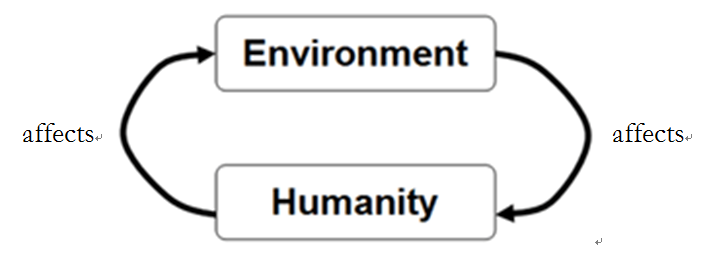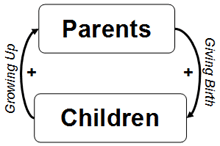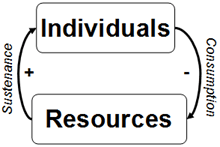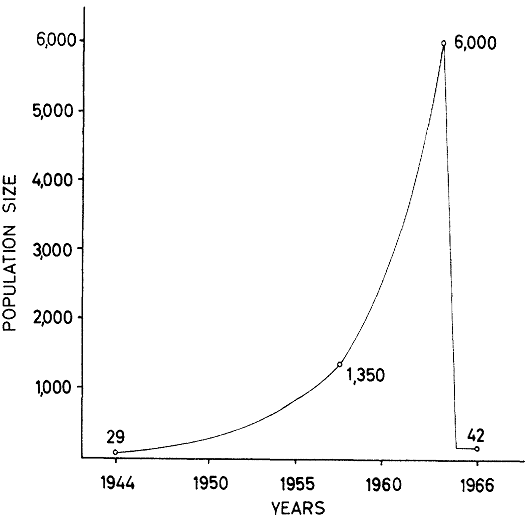What are feedback mechanisms and how do they work?
Let’s revisit that very simple human-environment systems diagram from the “What are coupled human-environment systems?” page:

The diagram in Figure 2.2 shows that humanity impacts the environment and that the environment impacts humanity. But if the environment impacts humanity, then that can in turn impact how humanity impacts the environment, which can in turn impact how the environment impacts humanity.
This phenomenon of system components both impacting each other creates afeedback loop. Feedback is an impact to a system component that is a consequence of an action performed by that component. For example, suppose you take the action of writing an email to the instructor, asking a question about the course. The email you get back is a feedback. A loop is a circumstance in which system components impact each other, such that an action by a component affects subsequent performances of that action. This circumstance has a circular, loop-like appearance in a systems diagram, as seen in the diagram above.
There are two basic types of feedback: positive and negative. A positive feedback loop is a circumstance in which performing an action causes more performances of the action. For example, suppose that every time you emailed the instructor with a question about the course, the instructor wrote back with an email so confusing that you had even more questions about the course, which cause you to write two emails back for more clarification. This would be a positive feedback loop.
A negative feedback loop is a circumstance in which performing an action causes fewer performances of the action. For example, suppose that every time you emailed the instructor with a question about the course, the instructor wrote back in an email that clarified the entire course for you, so that you had fewer questions about the course and thus wrote fewer emails for clarification. This would be a negative feedback loop.
It is important to understand that for feedback loops, the terms “positive” and “negative” do not mean good and bad. A positive feedback loop can be a bad thing, but also a necessary thing, while a negative feedback loop can be a good thing or vice versa. In most circumstances, whether or not any given feedback loop is positive or negative is ultimately an ethical question. We’ll cover ethics in Module 3.
Exceptions to the ethical nature of the feedback loop can be seen in the functioning of the body. For example, blood sugar regulation is a negative feedback loop for ingestion of the sugar glucose leads to the production of the hormone insulin and blood sugar levels increase before excess glucose is placed into storage until blood sugar levels decrease, which then causes the glucose to be released back to the blood. This negative feedback loop can be interrupted by malfunctions and leads to diabetes, but generally works well in most people. In contrast, a very important feedback loop exists to help a wound heal after a cut, hormones are released, which leads to blood flowing to the area that causes an increase in temperature, which leads to leads to other hormones and more blood cells until the wound seals, then the whole system collapses as it is no longer needed. As for you can see from these two examples, the functioning of our bodies is not an ethical choice and each system can work towards their goal of our health which is good. This type of maintenance is related to homeostasis, the balance of the system.
Self-check
Now that you have read a bit about what feedback loops entail, here are a few multiple-choice questions that will test your understanding of the differences between what a feedback loop is, and whether it is positive or negative feedback. These should be very simple questions and the purpose here is to give you some confidence in understanding this material so far.
Think About It!
Come up with an answer to these questions by yourself and then scroll to the bottom of the page below to reveal the answer.
1. An arms race is an example of:
a. Positive feedback
b. Negative feedback
c. Neither
2. Exponential population growth is an example of:
a. Positive feedback
b. Negative feedback
c. Neither
3. Body temperature control is an example of:
a. Positive feedback
b. Negative feedback
c. Neither
4. Population regulation is an example of:
a. Positive feedback
b. Negative feedback
c. Neither
Carrying Capacity
As the Self-check indicates, population change can involve either positive or negative feedback loops. When a population is growing exponentially, there is a positive feedback loop: more children bring more parents, which in turn bring even more children, and so on:

The plusses here signify that each set of parents brings more children, and each group of children brings more parents. If the birthrate is constant over time, and if each generation is larger than the previous, then there will be exponential population growth, as shown in Figure 2.10 in the Marten reading “What is Human Ecology?”(link is external) But population can’t maintain exponential growth forever. To do so would require an infinite amount of resources, but we live in a finite world. Here’s where the negative feedback loop comes in. The resources provide sustenance to the population: food, water, energy, or whatever other resources are being used. As the population runs out of resources, it can’t have as many children – or, the children can’t grow up to become parents.

The + here signifies that more resources bring more individuals since individuals need resources to survive. The – here signifies that more individuals bring fewer resources since a larger population will consume more, leaving fewer resources available for anyone else. If a population continues to grow exponentially for long enough, eventually it will hit a point where there aren’t enough resources for it to continue growing. At this point, the population has reached the largest size that the resources permit. This size is called the carrying capacity.
It is important to understand that the carrying capacity refers to the largest population that can be sustained over the long-term. Carrying capacity is not constant and varies over time in response to changes in the environment. For example, disturbances from extreme natural events (e.g., volcanic eruptions) and human activities (e.g., pollution) can alter the environment to a great extent and consequently influence carrying capacity.
A population can temporarily exceed the carrying capacity. For example, imagine a population of rabbits that lives off of carrots. The rabbits have to leave enough carrots in the ground each year so that they will have enough carrots to eat the following year. The carrying capacity is thus the largest number of rabbits that can live one year while still leaving enough carrots left over for the same number of rabbits to live the following year. The rabbits could exceed the carrying capacity one year, but then there wouldn’t be enough carrots the following year. To exceed the carrying capacity is called overshoot, as seen in Figure 2.11 of the Marten reading “What is human ecology?” Overshoot is followed by a major decline in population.
Reading Assignment: The St. Matthew Island Reindeers
A vivid example of population overshoot is found in the story of the reindeer that briefly lived on St. Matthew Island off the coast of Alaska. Please read the story in the following two articles by Ned Rozell:
St. Matthew Island — Overshoot and Collapse(link is external), Resilience, November 22, 2003.
What wiped out St. Matthew Island’s reindeer?(link is external), Anchorage Daily News, Published January 16, 2010; Updated December 29, 2017
As you read this, consider the following questions. When and why did the population crash occur? How could it have been prevented? Is the human population destined for the same fate? Why or why not?
Here’s a graph showing the reindeer’s exponential population growth and dramatic decline. As you examine the graph, consider how the graph relates to the story and to the concept of feedback mechanisms within a system.

Figure 2.5 Assumed population growth of St. Matthew Island reindeer herd. Actual counts are indicated in the population curve
Source: Klein, David R. (1968). The Introduction, Increase, and Crash of Reindeer on St. Matthew Island. The Journal of Wildlife Management:32 (2): 350-367 Wildlife Society
The full article is available via Penn State e-journals, in case you’re interested in reading it.
Carrying Capacity and Sustainability
Carrying capacity is closely related to sustainability. Sustainability is, in the simplest terms, the ability for something to be maintained into the future. If that something is a population, then for it to be sustained, it cannot exceed the carrying capacity of the system it’s living in. This is just a brief introduction to the idea of sustainability. There is a lot more to it. We’ll cover sustainability in more detail in the ethics module.
A key question in GEOG 030N – perhaps the key question – is whether today’s human population is sustainable. You might try to answer this question by comparing the human population to Earth’s carrying capacity for humans. But this is not an easy answer to provide! One reason is that the global human-environment system is very complex. Another reason is that human activity is changing the carrying capacity, in both positive and negative ways. In fact, it is important to consider whether the carrying capacity concept (which was developed to model non-human populations) can actually be applied to humans. Our behavior and consumption habits do not follow the same rules and patterns that we see in non-human populations. Many of the new technologies that we develop enable us to support larger populations, thereby increasing the carrying capacity. Some things we do such as unchecked timber harvesting deteriorate our resource base, lowering the carrying capacity. We also have economies, social and cultural customs, and government regulations that can influence and change resource use in both positive and negative ways. Given all this, no one is sure just how many people can be sustained on Earth over the long term. But we can get some important insights by studying human-environment systems, as we do in this course.
Answers to Self-check: 1. A, 2. A, 3. B, 4. B

